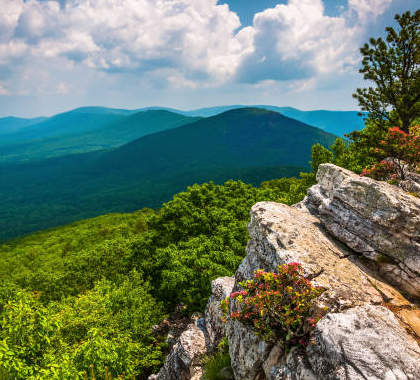Cities In West Virginia - Quick Facts, History & Geography
West Virginia Quick Facts
West Virginia was the 35th state to gain statehood on June 20, 1863. There are now a total of 401 cities, towns, and villages in West Virginia. West Virginia is the 41st largest city by land area with 24,230 square miles and is just 0.79% water. West Virginia is the 40th largest city by population with over 1.7 million residents. The capital city of West Virginia is Charleston and it is also the largest city with just 47,273 people. The highest point in West Virginia is Spruce Knob at 4,863 feet. West Virginia is home to several universities, including West Virginia University and Marshall University. The first Mother's Day was celebrated in West Virginia back in 1907. "Take Me Home, Country Roads" is the state song, famously performed by John Denver. West Virginia produces over 70,000 tons of coal annually, just under 14% of the nation's total. The West Virginia state nickname is the "Mountain State." Famous people born in West Virginia include Steve Harvey, Bill Withers, Don Knotts, Brad Paisley, Randy Moss and Morgan Spurlock.
The History of West Virginia
Before European contact, the area now known as West Virginia was home to various Native American tribes, including the Cherokee, Shawnee and Delaware. European explorers, including French and British traders, ventured into the area in the 17th and 18th centuries. The establishment of Fort Duquesne (later Fort Pitt) by the French marked an important presence in the region. The frontier nature of West Virginia led to conflicts between European settlers and Native American tribes. During the American Revolution, the region played a significant role. The Battle of Point Pleasant in 1774 marked one of the early conflicts between settlers and Native Americans. Amid the turmoil of the Civil War, West Virginia officially became a separate state on June 20, 1863. This unique event marked the only instance of a state forming within the boundaries of another during the Civil War. The Civil War deeply affected West Virginia, with battles and skirmishes taking place throughout the state. Its strategic location, vital resources like coal, and the presence of the B&O Railroad made it a focal point for both Union and Confederate forces. In the late 19th and early 20th centuries, West Virginia experienced rapid industrialization driven by coal mining and timber industries. In recent decades, West Virginia has faced economic challenges due to the decline of the coal industry. The state has focused on diversifying its economy, promoting education, and embracing technology to create new opportunities.
The Geography of West Virginia
West Virginia is bordered by Maryland, Virginia, Kentucky, Ohio and Pennsylvania. Dominating the landscape, the Appalachian Mountains traverse the state from the northeastern to the southwestern corner. This mountain range includes several distinct ridges and peaks, such as the Allegheny Mountains and the Blue Ridge Mountains. Nestled between the mountain ranges are numerous valleys and plateaus. The Great Appalachian Valley, also known as the "Valley and Ridge Province," stretches through parts of West Virginia, offering fertile land for agriculture and settlements. The Ohio River forms the western border of West Virginia, providing a crucial transportation route and serving as a boundary with Ohio, Kentucky, and parts of Indiana. Flowing through the state's capital, Charleston, the Kanawha River is a significant waterway for both transportation and recreation. The Eastern Panhandle extends into the fertile Shenandoah Valley and is located to the east of the main Appalachian mountain range. West Virginia is home to numerous caves and caverns, including Seneca Caverns and Lost World Caverns, offering visitors the chance to explore underground wonders. The state's mountainous terrain has made it a significant coal-producing region, with vast coal seams found within its mountains. Coal mining has played a pivotal role in the state's economy and history.
West Virginia Relocation Guide
As a state, West Virginia is a lot of things to a lot of people. There are mountains all over the place, which makes it somewhat difficult to navigate. The flip side of this is that travel is a big industry in West Virginia, with people coming from all over the east coast to ski at some of the amazing resorts. Places like Snowshoe and Winter Place have become very popular, so hotels and restaurants have popped up in the state to serve the needs of skiers who visit during the colder months. Additionally, West Virginia has a good size city in Charleston, as well as an advanced college city in Morgantown, which are great places to live.
The job market in cities in West Virginia have taken a pretty large hit since the recession, since a lot of the jobs were manufacturing based. Still, its proximity to Ohio, Maryland and Kentucky has made West Virginia a place that's surrounded by possibility. Those people who live in the bigger places enjoy lots of housing opportunities and it can be said that the cost of living in West Virginia is low no matter where you are. Housing is especially affordable - almost 25% less than that national average for cities in West Virginia. For this reason, many people decide to stay there to retire instead of relocating somewhere else.
Crime in West Virginia cities is, on average, very good. When compared to the national averages, West Virginia crime rates are more than 30% less than the U.S. Larger cities like Charlestown do have more crime than small cities, so care should be taken when deciding where to live.

